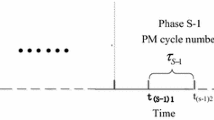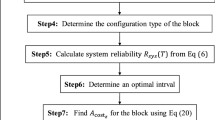Abstract
The costs of preventive maintenance have been extensively studied by scholars across all preventive optimization model disciplines. However, one phenomenon fails to be fully studied: breakdown and breakdown maintenance costs. We set out to fill this gap in this study. This study considered the cost of equipment preventive maintenance, and the breakdown maintenance cost caused by an accidental breakdown. In order to more accurately establish the reliability model of equipment breakdown, the three-parameter Weibull distribution was applied to set up the reliability model of equipment and the differential evolution algorithm was adopted to optimize the parameters. On this basis, preventive maintenance was regarded as imperfect maintenance in the study of preventive maintenance strategies for single equipment. In consideration of the combined influence of preventive maintenance and breakdown maintenance, a maintenance strategy in which preventive maintenance times N served as the decision variable was obtained to build a mathematical model on benefit expectation of single equipment in unit time. Based on the research of single equipment, a further study was performed on the multi-equipment series system. Moreover, two strategies were given, both of which use preventive maintenance times N as the decision variable. The first strategy is to take the average cost rate of the system under long-term operation as the optimization objective, while the second strategy is to apply single component maintenance strategy in series system. In the numerical example study, a series manufacturing system composed of two devices was chosen as the research object. Interestingly, we discussed the effect of initial conditions of two-parameter DE on output results. After acquiring the optimal initialization parameters, the failure rate function was achieved by the DE to estimate the parameters of three-parameter Weibull distribution. Meanwhile, the maintenance times N was optimized according to the two strategies respectively. The best result were selected from the results of both strategies based on availability. Thus, the validity and practicability of the proposed research methods are verified.





Similar content being viewed by others
References
Adhikary, D. D., Bose, G. K., Jana, D. K., Bose, D., & Mitra, S. (2015). Availability and cost-centered preventive maintenance scheduling of continuous operating series systems using multi-objective genetic algorithm: A case study. Quality Engineering,28(3), 352–357.
Aghezzaf, E.-H., Khatab, A., & Tam, P. L. (2016). Optimizing production and imperfect preventive maintenance plannings integration in failure-prone manufacturing systems. Reliability Engineering and System Safety,145, 190–198.
Beichelt, (2010). Minimax inspection strategies for single unit systems. Naval Research Logistics,28(3), 375–381.
Bergman, B. (1978). Optimal replacement under a general failure model. Advances in Applied Probability,10(2), 431–451.
Chalabi, N., Dahane, M., Beldjilali, B., & Neki, A. (2016). Optimisation of preventive maintenance grouping strategy for multi-component series systems. Computers and Industrial Engineering,102, 440–451.
Cheng, G., Ling, L., & Tang, Y. (2010). An optimal replacement policy for a degenerative repairable system. Journal of Shandong University,45(5), 106–110.
Cheng, Z., Yang, Z., & Tan, L. (2013). Notice of Retraction Hybrid preventive maintenance and inspection scheduling for a multi-unit series system. In International conference on quality, reliability, risk, maintenance, and safety engineering (pp. 626–631). IEEE.
Chunping, H., Wang, C., & Yan, X. (2012). A self-adaptive differential evolution algorithm based on ant system with application to estimate kinetic parameters. Optimization,61(1), 99–126.
Costa, L., Santo, I. E., & Oliveira, P. (2013). An adaptive constraint handling technique for evolutionary algorithms. Optimization,62(2), 241–253.
Drinkwater, R. W., & Hastings, N. A. J. (1967). An economic replacement model. Journal of the Operational Research Society,18(2), 121–138.
Dui, H., Si, S., & Yam, R. C. M. (2017). A cost-based integrated importance measure of system components for preventive maintenance. Reliability Engineering and System Safety,168, 98–104.
Fallahnezhad, M. S., & Najafian, E. (2016). A model of preventive maintenance for parallel, series, and single-item replacement systems based on statistical analysis. Communication in Statistics-Simulation and Computation,46(7), 5846–5859.
Gao, Y., Feng, Y., Zhang, Z., & Tan, J. (2015). An optimal dynamic interval preventive maintenance scheduling for series systems. Reliability Engineering and System Safety,142, 19–30.
Gupta, M. K., Sood, P. K., & Sharma, V. S. (2016). Optimization of machining parameters and cutting fluids during nano-fluid based minimum quantity lubrication turning of titanium alloy by using evolutionary techniques. Journal of Cleaner Production,135, 1276–1288.
Gustavsson, E., Patriksson, M., & Wojciechowski, A. (2014). Preventive maintenance scheduling of multi-component systems with interval costs. Computers and Industrial Engineering,76(C), 390–400.
Haoues, M., Dahane, M., & Mouss, N. K. (2016). Outsourcing optimization in two-echelon supply chain network under integrated production-maintenance constraints. Journal of Intelligent Manufacturing. https://doi.org/10.1007/s10845-016-1273-3.
Huang, C. H., & Wang, C. H. (2014). Optimization of preventive maintenance for a multi-state degraded system by monitoring component performance. Journal of Intelligent Manufacturing,27(6), 1–20.
Jayabalan, V., & Chaudhuri, D. (1992). Optimal maintenance and replacement policy for a deteriorating system with increased mean downtime. Naval Research Logistics,39(1), 67–78.
Khatab, A. (2015). Hybrid hazard rate model for imperfect preventive maintenance of systems subject to random deterioration. Journal of Intelligent Manufacturing,26(3), 601–608.
Khatab, A. (2018). Maintenance optimization in failure-prone systems under imperfect preventive maintenance. Journal of Intelligent Manufacturing,4, 1–11.
Khatab, A., Diallo, C., & Sidibe, I. (2017). Optimizing upgrade and imperfect preventive maintenance in failure-prone second-hand systems. Journal of Manufacturing Systems,43, 58–78.
Lam, Y. (1988). A note on the optimal replacement problem. Advances in Applied Probability,20(2), 479–482.
Liao, G.-L. (2013). Joint production and maintenance strategy for economic production quantity model with imperfect production processes. Journal of Intelligent Manufacturing,24(6), 1229–1240.
Liao, W., Pan, E., & Xi, L. (2010). Preventive maintenance scheduling for repairable system with deterioration. Journal of Intelligent Manufacturing,21(6), 875–884.
Lie, C. H., & Chun, Y. H. (1986). An algorithm for preventive maintenance policy. Reliability IEEE Transactions on,35(1), 71–75.
Lin, T. W., & Wang, C. H. (2012). A hybrid genetic algorithm to minimize the periodic preventive maintenance cost in a series-parallel system. Journal of Intelligent Manufacturing,23(4), 1225–1236.
Mia, M., & Dhar, N. R. (2017). Prediction and optimization by using svr, rsm and ga in hard turning of tempered aisi 1060 steel under effective cooling condition. Neural Computing and Applications,1, 1–22.
Morimura, H. (1969). On some preventive maintenance policies for IFR. Journal of the Operations Research society of Japan,6(1), 94–124.
Nedic, N., Prsic, D., Fragassa, C., Stojanović, V., & Pavlovic, A. (2017). Simulation of hydraulic check valve for forestry equipment. International Journal of Heavy Vehicle Systems,24(3), 260–276.
Nourelfath, M., & Châtelet, É. (2011). Oprimization of redundancy and imperfect preventive maintenance for series-parallel multi-state systems. Journal of Applied Physiology,72(1), 143–148.
Nourelfath, M., Châtelet, E., & Nahas, N. (2012). Joint redundancy and imperfect preventive maintenance optimization for series–parallel multi-state degraded systems. Reliability Engineering and System Safety,103(4), 51–60.
Park, K. S. (2009). Optimal number of minimal repairs before replacement. IEEE Transactions on Reliability,R-28(2), 137–140.
Peng, W., Huang, H. Z., Zhang, X., Liu, Y., & Li, Y. (2009). Reliability based optimal preventive maintenance policy of series-parallel systems. Eksploatacja i Niezawodnosc—Maintenance and Reliability,42(2), 4–7.
Price, K., Storn, R. M., & Lampinen, J. A. (2005). Differential evolution: A practical approach to global optimization (natural computing series). New York Inc: Springer.
Raju, M., Gupta, M. K., Bhanot, N., & Sharma, V. S. (2018). A hybrid pso–bfo evolutionary algorithm for optimization of fused deposition modelling process parameters. Journal of Intelligent Manufacturing,1, 1–16.
Ronkkonen, J., Kukkonen, S., & Price, K. V. (2005). Real-parameter optimization with differential evolution. In Proceedings of 2005 IEEE congress on evolutionary computation (vol. 1, pp. 506–513).
Shafiee, M., Finkelstein, M., & Ming, J. Z. (2013). Optimal burn-in and preventive maintenance warranty strategies with time-dependent maintenance costs. IIE Transactions,45(9), 1024–1033.
Singh, G. R., Gupta, M. K., Mia, M., & Sharma, V. S. (2018). Modeling and optimization of tool wear in mql-assisted milling of inconel 718 superalloy using evolutionary techniques. International Journal of Advanced Manufacturing Technology,13, 1–14.
Stadje, W., & Zuckerman, D. (1990). Optimal strategies for some repair replacement models. Advances in Applied Probability,22(3), 641–656.
StenstrÃm, C., Norrbin, P., Parida, A., & Kumar, U. (2016). Preventive and corrective maintenance â “cost comparison and cost” â benefit analysis. Structure and Infrastructure Engineering,12(5), 603–617.
Stojanovic, V., & Nedic, N. (2016). A nature inspired parameter tuning approach to cascade control for hydraulically driven parallel robot platform. Journal of Optimization Theory and Applications,168(1), 332–347.
Storn, R., & Price, K. (1995). Differential evolution-a simple and efficient adaptive scheme for global optimization over continuous spaces. Berkley: Technical Report International Computer Science Institute.
Storn, R., & Price, K. (1997). Differential evolution—A simple and efficient heuristic for global optimization over continuous spaces. Journal of Global Optimization,11(4), 341–359.
Tasgetiren, M. F., Suganthan, P. N., & Pan, Q. K. (2010). An ensemble of discrete differential evolution algorithms for solving the generalized traveling salesman problem. Applied Mathematics and Computation, 215(9), 3356–3368.
Wang, H. (2002). A survey of maintenance policies of deteriorating systems. European Journal of Operational Research,139(3), 469–489.
Wang, C. H., & Tsai, S. W. (2014). Optimizing bi-objective imperfect preventive maintenance model for series-parallel system using established hybrid genetic algorithm. Journal of Intelligent Manufacturing,25(3), 603–616.
Yahyatabar, A., & Najafi, A. A. (2017). A quadratic reproduction based invasive weed optimization algorithm to minimize periodic preventive maintenance cost for series-parallel systems. Computers and Industrial Engineering,110, 436–461.
Yun, W. Y., & Bai, D. S. (1987). Cost limit replacement policy under imperfect repair. Reliability Engineering,19(1), 23–28.
Zhang, M., Gaudoin, O., & Xie, M. (2015). Degradation-based maintenance decision using stochastic filtering for systems under imperfect maintenance. European Journal of Operational Research,245(2), 531–541.
Zhang, Y. L., & Wang, G. J. (2010). An optimal replacement policy for a multistate degenerative simple system. Applied Mathematical Modelling,34(12), 4138–4150.
Zhang, M., & Xie, M. (2017). An ameliorated improvement factor model for imperfect maintenance and its goodness of fit. Technometrics,59(2), 237–246.
Zhou, X., Xi, L., & Lee, J. (2007). Reliability-centered predictive maintenance scheduling for a continuously monitored system subject to degradation. Reliability Engineering and System Safety,92(4), 530–534.
Zied, H., Sofiene, D., & Nidhal, R. (2014). Joint optimisation of maintenance and production policies with subcontracting and product returns. Journal of Intelligent Manufacturing,25(3), 589–602.
Author information
Authors and Affiliations
Corresponding author
Additional information
Publisher's Note
Springer Nature remains neutral with regard to jurisdictional claims in published maps and institutional affiliations.
Rights and permissions
About this article
Cite this article
Wang, X., Guo, S., Shen, J. et al. Optimization of preventive maintenance for series manufacturing system by differential evolution algorithm. J Intell Manuf 31, 745–757 (2020). https://doi.org/10.1007/s10845-019-01475-y
Received:
Accepted:
Published:
Issue Date:
DOI: https://doi.org/10.1007/s10845-019-01475-y




